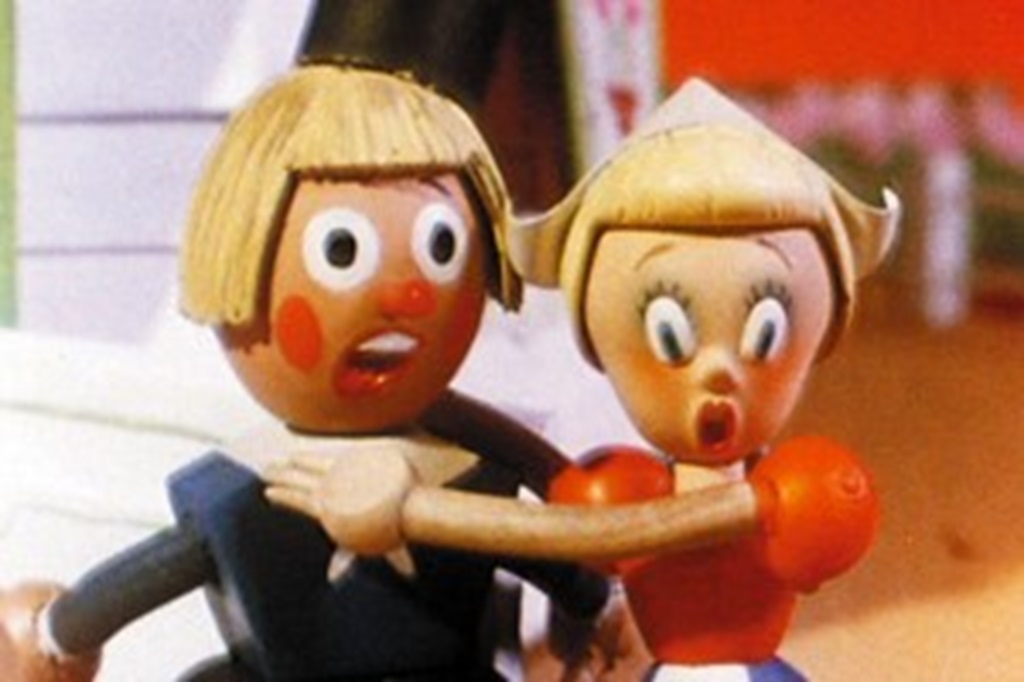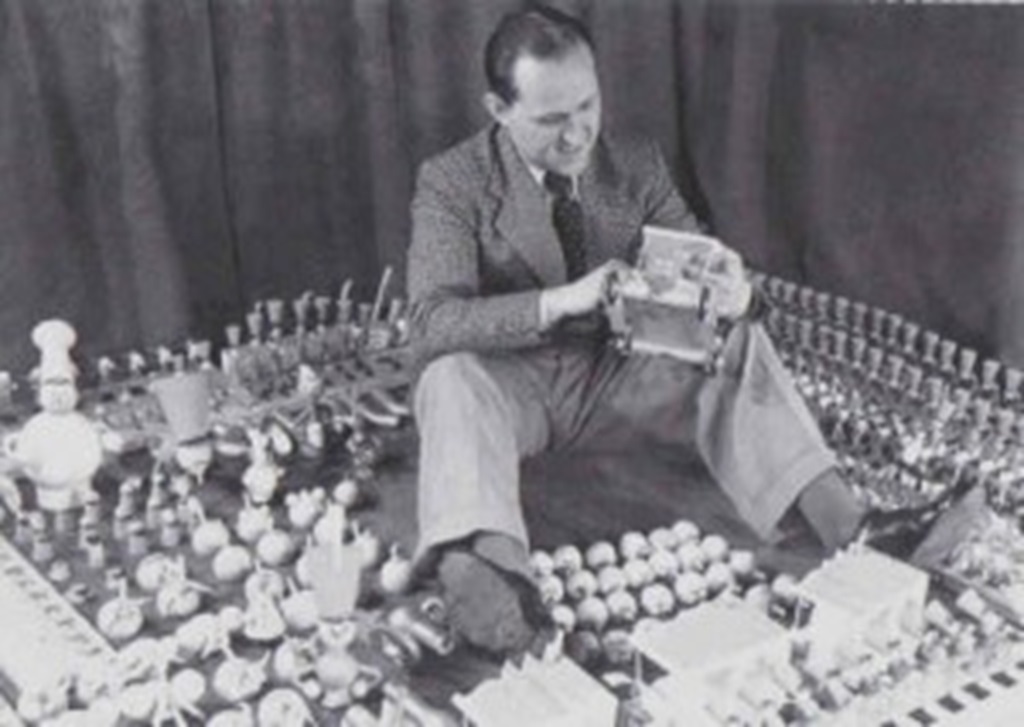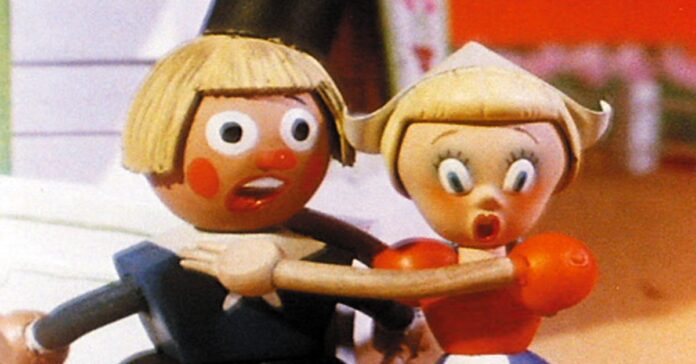The Puppetoon Movie, released in 1987 and written, produced, and directed by Arnold Leibovit, is an animated film that draws inspiration from the Puppetoons characters developed by George Pal in the 1930s and 1940s.
George Pal, a producer-director often likened to Walt Disney, was recognized for his remarkable work in the sci-fi/fantasy genre, notably films like Destination Moon (1950), When Worlds Collide (1951), The War of the Worlds (1953), tom thumb (1958), The Time Machine (1960), and The Wonderful World of the Brothers Grimm (1962).
Before this, Pal gained acclaim for his Puppetoons, short films employing a unique form of three-dimensional replacement animation.
Unlike stop-motion, which involves articulating a single model frame by frame, Pal’s Puppetoons required the creation of numerous heads and legs for each character, resulting in exceptionally smooth and expressive motion.
Despite being born in Hungary, Pal established his Puppetoons series at Paramount Pictures in Hollywood, producing around thirty shorts between 1940 and 1947.
These films, originally titled “Madcap Models” by Paramount, were showcased at a nitrate film festival at UCLA, leaving audiences captivated by their vibrant three-strip Technicolor visuals.
BLU-RAY REVIEW: THE PUPPETOON MOVIE
Regrettably, the Puppetoons have not enjoyed the same enduring presence as Disney’s and Warner Bros.’ cartoons.
This is partly due to the limited number of shorts, which made establishing a regular children’s television show challenging.
Additionally, some of the shorts were distributed in black-and-white and faced challenges related to political correctness.
Producer and archivist Arnold Leibovit released the documentary The Fantasy Film Worlds of George Pal (1985) and The Puppetoon Movie (1987) to revive George Pal’s legacy.
The new 2-disc Blu-ray of The Puppetoon Movie, available at www.b2mp.net and limited to 3,000 copies, comprises two feature films, bonus shorts in high-definition, and The Fantasy Film Worlds of George Pal in standard-definition, along with various additional features.
The set not only features The Puppetoon Movie and The Great Rupert (1950), Pal’s first live-action feature but also includes seven bonus shorts released for the first time in any home video format, all restored in high-definition by the UCLA Film & Television Archives and the Academy of Motion Picture Arts & Sciences.

Also, see DVD Review: “Providence” (1977)
The Puppetoon Movie begins with an impressive animated prologue, overseen by Pete Kleinow, featuring a gentle Arnie the Dinosaur advising a Bambi-like fawn to run away from a Tyrannosaurus Rex.
The entire scene is part of a movie being directed by Gumby and assisted by Pokey.
Arnie, who became a vegetarian under the influence of producer George Pal’s inspiring Puppetoon shorts, leads the characters into an editing room adorned with posters from Pal’s features to view some of Pal’s best shorts on a Moviola.
The Film then transitions into a Puppetoon film festival, showcasing three pre-Hollywood shorts, namely Philips Cavalcade (1934), The Sleeping Beauty (1935), and Philips Broadcast of 1938 (1938), followed by seven Paramount Puppetoons, each presented with their original main titles: Hoola Boola (1941), Tulips Shall Grow (1942), The Little Broadcast (1943), Jasper in a Jam, Together in the Weather, John Henry and the Inky-Poo (all 1946), and Tubby the Tuba (1947).
The movie concludes with a heartfelt tribute to the late producer, featuring various stop-motion characters, including King Kong, The Pillsbury Dough Boy, and Alka-Seltzer’s Speedy in cameo appearances.
While renowned animators like Willis O’Brien and Ray Harryhausen contributed to these shorts, Pal’s distinctive style and interests are prevalent.
For instance, one of the standout shorts, Tulips Shall Grow, serves as a parable mirroring Nazi Germany’s invasion of Holland, a place where Pal had previously worked before relocating to London and later America.
These shorts also reflect Pal’s passion for both classical and contemporary music, as evidenced by the inclusion of a character resembling Leopold Stokowski in the shorts and the endearing story of Tubby the Tuba, who longs to play a beautiful melody instead of the typical Oompah-Pah orchestrations.
The shorts encompass a wide range, featuring distinctly European-flavored adaptations of classic fairy tales such as The Sky Princess and Jasper and the Beanstalk (included among the extra features, with the latter showcasing Peggy Lee’s singing voice), animated interpretations of modern jazz (Jasper in a Jam, Rhythm in the Ranks, and Date with Duke, the latter featuring Duke Ellington), a particular focus on American folklore, and even early Dr. Seuss stories.
Pal faced criticism during and after the Puppetoon era for occasional racial stereotypes.
Pal, the most popular Puppetoon character, perceived Jasper as the “Huckleberry Finn of [African-] American Folklore” but faced backlash in publications like Ebony.
Despite racial stereotypes reflective of the times, they are portrayed without malice. Jasper is depicted as an ordinary little boy who happens to be black.
Moreover, in all-black shorts like John Henry and the Inky-Poo, Pal presented overwhelmingly positive portrayals of black characters in stories dominated by African Americans at a time when Hollywood predominantly relegated them to minor roles in narratives entirely dominated by white characters.
The high-definition transfer of The Puppetoon Movie, formatted at 1.37:1, is sourced from a 35mm interpositive, resulting in the original Puppetoons looking quite impressive, particularly the prologue-epilogue.
Initially mixed for 4-track stereo, it has been remixed for DTS-MA 4.0 surround and 24-bit 48kHz stereo, enhancing the overall experience.
The additional high-definition shorts, including Date with Duke (1940), Rhythm in the Ranks (1941), The Sky Princess (1942), The 500 Hats of Bartholomew Cubbins (1943), And To Think I Saw It On Mulberry Street (1944), Jasper and the Beanstalk (1945), and Rhapsody in Wood (1947), are even more visually impressive than the shorts in the main feature.
Moreover, twelve more shorts, originally part of the DVD version of The Puppetoon Movie, are included in standard definition, such as What Ho She Bumps, Mr. Strauss Takes a Walk, Olio for Jasper, Philips Cavalcade, Jasper’s Derby, Hoola Boola, Ether Symphony, Aladdin and His Magic Lamp, The Magic Atlas, Jasper and the Haunted House, The Philips Broadcast of 1938, and The Ship of the Ether.

The Great Rupert (1950), also available in high-definition, marked George Pal’s debut as a feature film producer and was initially distributed by Eagle-Lion.
This fantasy-comedy revolves around a remarkably talented performing squirrel whose innocent yet profound influence impacts the lives of two families, achieving modest success.
The Film opens with Vaudevillian Joe Mahoney rehearsing with the squirrel, Rupert, who has been taught to perform a Highland Fling in full Scottish attire.
However, despite their efforts, Mahoney’s agent shows no interest, leading to their eviction for rent arrears.
Subsequently, the Amendola family, including juggler Louie Amendola, his wife, and daughter Rosalinda, move in, oblivious to Rupert’s return to the nest above their flat.
Meanwhile, their landlord, Frank Dingle, receives monthly payments of $1,500, which he hides behind a wall, unknowingly depositing it directly into Rupert’s nest.
Facing financial difficulties, Mrs. Amendola prays for a miracle, coinciding with Rupert tossing out the unwanted money, leading her to interpret the fluttering bills as an answered prayer.
More so than Pal’s subsequent works, The Great Rupert shares similarities with the early comedies of Preston Sturges, particularly Christmas in July (1940), which shares a comparable plot.
The inclusion of Jimmy Conlin, a member of Sturges’s ensemble of character actors, further supports this connection, along with the humor and the story’s ultimately happy conclusion.
Rupert, credited as playing himself, is portrayed by a natural squirrel for part of the time, with approximately 50% of his scenes achieved through stop-motion animation.
The seamless integration of live-action and animation made many assume he was an exceptionally well-trained animal.
While the movie loses some focus when Rupert is sidelined for much of the second half, it undeniably reflects Pal’s distinctive touch and his aspiration to produce a heartwarming, enchanting family film.
Pal’s gentle nature is also evident in The Fantasy Film Worlds of George Pal, a more traditional yet captivating documentary featuring interviews with individuals such as Alan Young, Russ Tamblyn, Ray Bradbury, Roy Disney, and others, highlighting both his remarkable contributions as a filmmaker and his exceptional kindness as a person.
The bonus disc includes approximately 40 minutes of extended interviews.
The Blu-rays additionally feature an audio commentary on The Puppetoon, featuring Leibovit and animation historian Jerry Beck, who also provide enlightening liner notes.
Additionally, there is footage of Pal at a Cinerama premiere for The Wonderful World of the Brothers Grimm and on the set of Destination Moon.
The combination of The Puppetoon Movie, The Great Rupert, The Fantasy Worlds of George Pal, and the bonus Puppetoons, along with the supplementary material, makes it one of the top Blu-ray releases of the year.
On a scale of Excellent, Good, Fair, and Poor, The Puppetoon Blu-ray rates:
The Film (out of ****): ***1/2
Film Elements Sourced: ***1/2
Video Transfer: ****
Audio: ****
New Extra Features: ****
Extra Features Overall: ****
Arnold Leibovit Entertainment/B2MP
1987 / Color / 1:37:1 / 79 plus 88 min (feature films) / $49.98

